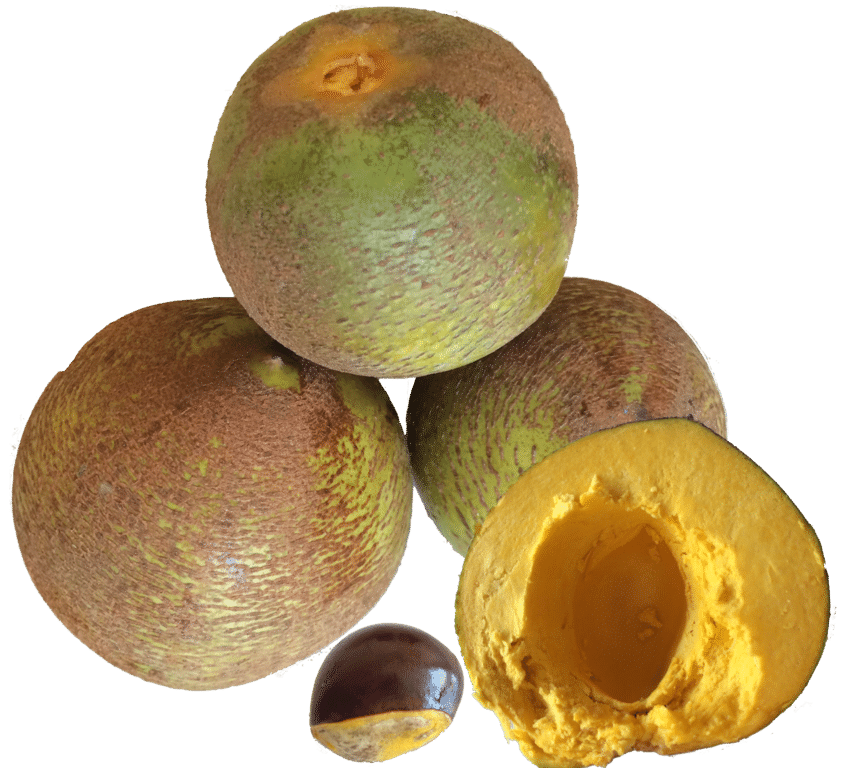Lucuma:
What is it?, history, cultivation, nutritional value, uses, recipes, and more...
Lucuma, also known as the “gold of the Incas,” is a fruit native to the Andean valleys of Peru. It is used in the preparation of sweets, sweeteners, desserts, and ice creams, and has important medicinal properties.
Índice
What is Lucuma?
Lucuma is a tree of the Sapotaceae family, native to the Andean valleys of Ecuador, Peru, Bolivia, and Chile, from which the fruit of Lucuma originates. It is mainly cultivated for its diverse culinary uses.
Lucuma is a perennial, straight, and cylindrical tree that can reach up to fifteen meters in height. Its wood is light, fine-grained, and resistant. Its canopy is dense and rounded in shape. The leaves are concentrated at the apex of the tender branches and have an elliptical shape with a flattened base. They measure between 12 and 25 centimeters in length, have a leathery texture, and a dark green color on the underside.
The flowers of Lucuma are solitary or in clusters of two or three. They are tubular in shape, small, and either yellow or greenish, always hermaphroditic. Its fruit, the Lucuma, is a spherical berry with a thin green or bronzed yellow skin, depending on its degree of ripeness. It measures up to 15 cm in length in cultivated varieties and weighs about 200 grams. The flesh is yellow-orange, somewhat dry, starchy, and has a very sweet taste and aroma. It contains two to five oval and flattened seeds, dark brown in color, with a whitish filum on one side.
History of Lucuma
According to archaeological research, Lucuma was domesticated in the inter-Andean valleys of pre-Inca civilizations in countries like Ecuador, Peru, and Chile, where its consumption and the use of the tree’s wood are extensively documented in the pictorial representations of native peoples.
There is a legend that tells the story of an Andean goddess who refused to fall in love until she was conquered by a mythical being disguised as a beggar, who offered her a Lucuma fruit. In Inca mythology, Lucuma represents fertility.
The oldest evidence of Lucuma usage comes from seeds obtained from Complex II (between 8600 BC and 5600 BC) in the Guitarrero Cave in the Callejón de Huaylas in Ancash, Peru. Additionally, Lucuma representations have been found in ceramics of the Moche culture, as well as in the tombs of their rulers and nobility.
It is also known that the wood of the Lucuma tree was used in the construction of the Pachacamac sanctuary, where a uniquely carved trunk was discovered in 1938.
It is believed that Lucuma cultivation was widespread in all Inca valleys, with its peak occurring during the Moche or Mochica culture around the 1st to 7th century AD. This civilization employed irrigation techniques and intensive cultivation to produce unprecedented quantities of the fruit. Before the arrival of the Spanish, Lucuma was one of the main ingredients in the diet of the indigenous people of the valley, along with corn, legumes, guava, as well as quinoa and kiwicha in higher regions.
Europeans became aware of Lucuma in Manabí, Ecuador, in 1531. Today, it is known that this fruit is cultivated in various regions of Peru. In Bolivia, it is produced near La Paz, in Chile mainly in the Coquimbo Region, and in Costa Rica, where it was introduced by migrants in the early 20th century, around San José.

Common name of Lucuma
| Español | Lúcumo, lucmo, lucma |
| Quechua | Rucma |
| Inglés | Eggfruit |
Scientific name of Lucuma
Pouteria lucuma
Taxonomy of Lucuma
| Reino | Plantae |
| Subreino | Tracheobionta |
| División | Magnoliophyta |
| Clase | Magnoliopsida |
| Subclase | Dilleniidae |
| Orden | Ericales |
| Familia | Sapotaceae |
| Subfamilia | Chrysophylloideae |
| Género | Pouteria |
| Especie | P. lúcuma (Ruiz & Pav.) Kuntze |
Synonymy of Lucuma
Achras lucuma Ruiz & Pav., Fl. Peruv. 3: 17 (1802).
Richardella lucuma (Ruiz & Pav.) Aubrév., Adansonia, n.s., 1: 175 (1962).
Lucuma bifera Molina, Sag. Stor. Nat. Chili: 187 (1782), provisional synonym.
Lucuma turbinata Molina, Sag. Stor. Nat. Chili: 187 (1782), provisional synonym.
Lucuma obovata Kunth in F.W.H.von Humboldt, A.J.A.Bonpland & C.S.Kunth, Nov. Gen. Sp. 3: 241 (1819).
Lucuma obovata var. ruizii A.DC. in A.P.de Candolle, Prodr. 8: 172 (1844).
Pouteria insignis Baehni, Candollea 9: 356 (1942).
Etymology of Lucuma
Lucuma comes from the Quechua phrase “lluku uma,” which means “old man’s head.”
Habitat of Lucuma
- Habitat
Habitat of Lucuma
In Peru, the natural habitat of Lucuma is the lower sierra, but it grows adequately from sea level up to 3,000 meters in altitude. However, the most optimal conditions are around 500 meters, with temperatures ranging from 8 to 27 degrees Celsius and humidity between 80% and 90%. This plant is not frost-resistant and dies at temperatures below -5°C. It prefers sandy, well-drained soils with a certain level of salinity and a neutral pH.
Lucuma does not require constant irrigation and can tolerate brief periods of drought as well as rainy seasons. However, it does not withstand prolonged humid climates or very high temperatures.
The quality of Lucuma fruit varies drastically depending on the cultivation conditions. It produces between 200 and 300 fruits per year from the fourth or fifth year onwards, although it can produce approximately 500. The production is better in specimens produced by cuttings rather than seed-planted ones. The fruits can reach a weight of 1 kg, and the yield is continuous throughout the year.
In Peru, its cultivation increases every year due to high local and international demand. COPROBA, an organization of the Peruvian government, has declared it one of Peru's flagship products (INDECOPI, 2013).
Geographical distribution of Lucuma

Piura, La libertad, Ancash, Lima, Ica, Arequipa, Tacna, Ayacucho, Huancavelica, Junín, Pasco, Huánuco, Cajamarca, Cuzco
Seasonal availability of Lucuma
- January, February, March, August, September, October, November
Varieties of Lucuma
In our country, two types of Lucuma are distinguished mainly by their size and texture:
-
Silky Lucuma
-
Wooden Lucuma
Nutritional value of Lucuma
Lucuma is rich in nutrients, fiber, and antioxidants, including beta-carotene, essential for cellular health and responsible for stimulating cell repair and the growth of new cells, including skin cells. It also provides vitamin B3, which promotes muscle development and is recommended for those who do not consume much meat. Lucuma contains valuable minerals such as potassium, which contributes to cardiovascular health, as well as calcium, phosphorus, and ironthat are essential for preventing anemia, malnutrition, and strengthening the immune system.
Additionally, Lucuma is rich in vitamin C, which stimulates collagen production, provides tissue elasticity, and helps with digestive problems by contributing to the repair of intestinal walls.
One of its most appreciated properties is its very low glycemic index, which promotes blood sugar and insulin stabilization, making it recommended for people with diabetes and used as a natural sweetener.
Health benefits of Lucuma
Lucuma is an excellent natural energizer that provides fiber, potassium, vitamin B3, and carotenoids, among other nutrients.
Contraindications or side effects
Although there is no scientific evidence of possible side effects of Lucuma, due to its antidepressant effect, its consumption is not recommended for people undergoing pharmacological antidepressant treatments. Also, it is not recommended to consume it at night due to its invigorating effects, which could cause insomnia, fatigue, or stress.
| 10 Porciones por Kilogramo | |
| Tamaño de porción | 100g |
| Cantidad por porción Calorías |
97 |
| Cantidad por 100g | |
| Energía | 406 kJ |
| Grasa Total | 0.2 g |
| Sodio | ● |
| Carbohidratos totales | 34.9 g |
| Carbohidratos disponibles | 24.7 g |
| Fibra Dietaria | 10.2 g |
| Proteínas | 2.1 g |
| Calcio | 16 mg |
| Fósforo | 26 mg |
| Zinc | ● |
| Hierro | 0.79 mg |
| Potasio | ● |
| Agua | 61.7 g |
| Cenizas | 1.2 g |
| Vitamina A | 292 μg |
| Tiamina (B1) | 0.01 mg |
| Riboflavina (B2) | 0.14 mg |
| Niacina (B3) | 1.96 mg |
| Vitamina C | 0.77 mg |
| Acido Fólico (B9) | ● |
| β-Caroteno | 1,750 μg |
| Fuente: Tablas peruanas de composición de alimentos – Centro Nacional de Alimentación y Nutrición – Ministerio de Salud – Perú | |
Derived Products and Consumption Forms of Lucuma
Uses of Lucuma
Lucuma is primarily used for its nutritional properties and its versatility in consumption, making it a highly coveted export product in gastronomy.
- Culinary
- Medicinal
- Industrial
Culinary use of Lucuma
According to experts, Lucuma has an intense flavor reminiscent of maple syrup but much superior. While it can be consumed raw, it is more commonly cooked and used in tarts, cakes, ice creams, smoothies, puddings, and other desserts. In Peru, its use in desserts, ice creams, and sweets has been widespread since pre-Columbian times, making it a national fruit and a flagship product.
Due to its high starch content, Lucuma pulp is used to make Lucuma flour, which is very sweet and nutritious, rich in iron and niacin, and used in the production of numerous products. The only nutrient it loses when processed into powder is carotene, and it is suitable for those with celiac disease as it is gluten-free.
Lucuma powder can be used as a sugar substitute and is a good flavor enhancer, commonly used to sweeten teas, coffee, juices, smoothies, sauces, yogurts, jams, and more.
Its exoticism and properties have led to an increased demand for Lucuma in various places, including Europe and Japan, where it is used in world-renowned restaurants.
Medicinal Use of Lucuma
Lucuma provides significant nutrients such as fiber, phosphorus, calcium, iron, thiamine, niacin, vitamin C, A, and riboflavin. It also has a low glycemic index. It contributes vitamin B3 or niacin, which helps reduce cholesterol and triglycerides in the blood and is recommended for proper neuronal function, short-term memory maintenance, combating chronic fatigue, and depressive states.
Furthermore, as a natural sweetener, Lucuma avoids all the problems associated with sugar consumption:
Reduces calorie intake and aids in weight loss. Protects dental health. Prevents and controls diabetes. Manages reactive hypoglycemia. Eliminates processed foods from the diet.
Industrial Use of Lucuma
Due to the light but compact nature of Lucuma wood, it is used for industrial and construction purposes.
Additionally, due to its skin benefits, such as anti-inflammatory, antioxidant, and reparative properties, it has been used in the cosmetic industry in creams and shampoos.
In 2018, according to the Ministry of Foreign Trade and Tourism (Mincetur) and the SUNAT, Lucuma was already exported from Peru to 41 countries. From January to October 2020, it exported 1,146,234 kilograms of Lucuma flour with an FOB value of US$7,390,103. These figures represent a significant increase compared to the 124,545 kilograms exported in a similar period in 2019, valued at US$1,175,742 at that time.



